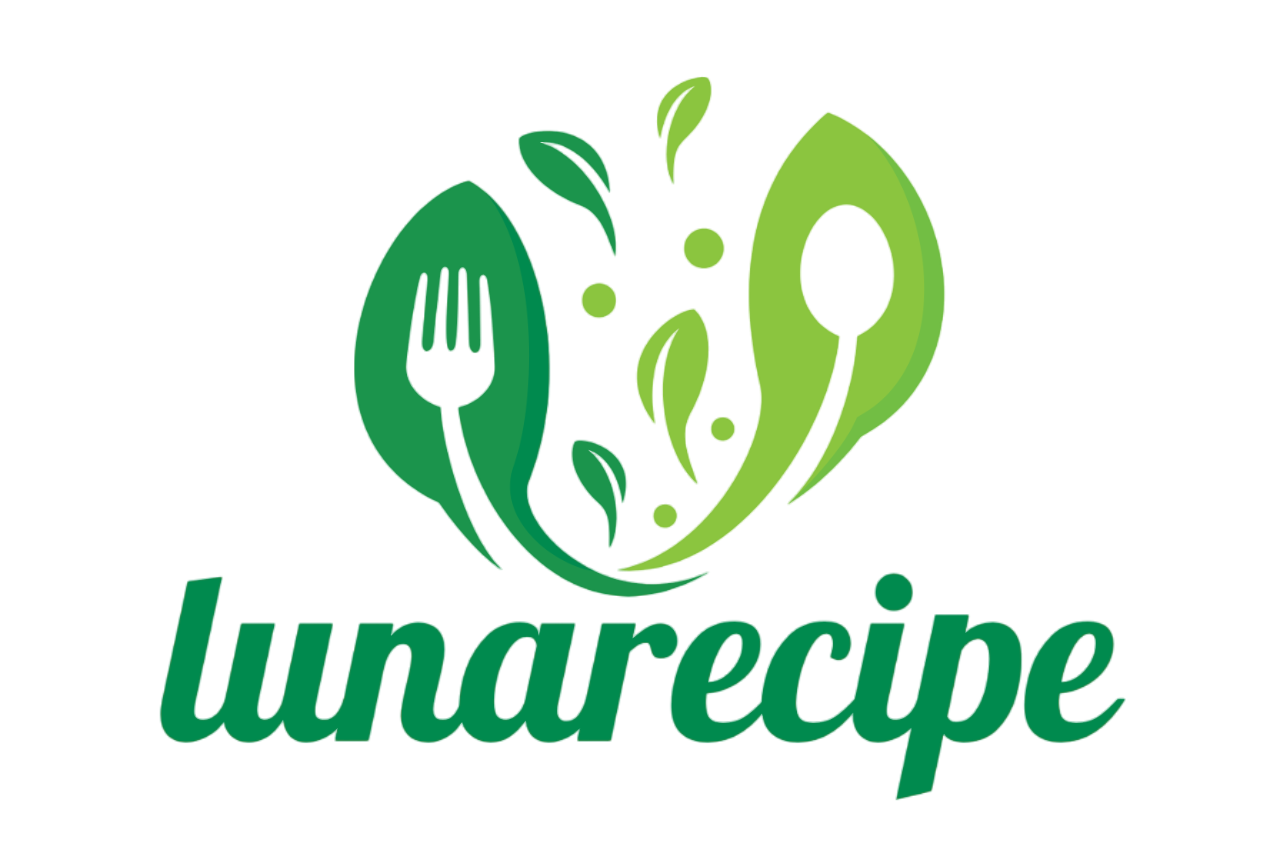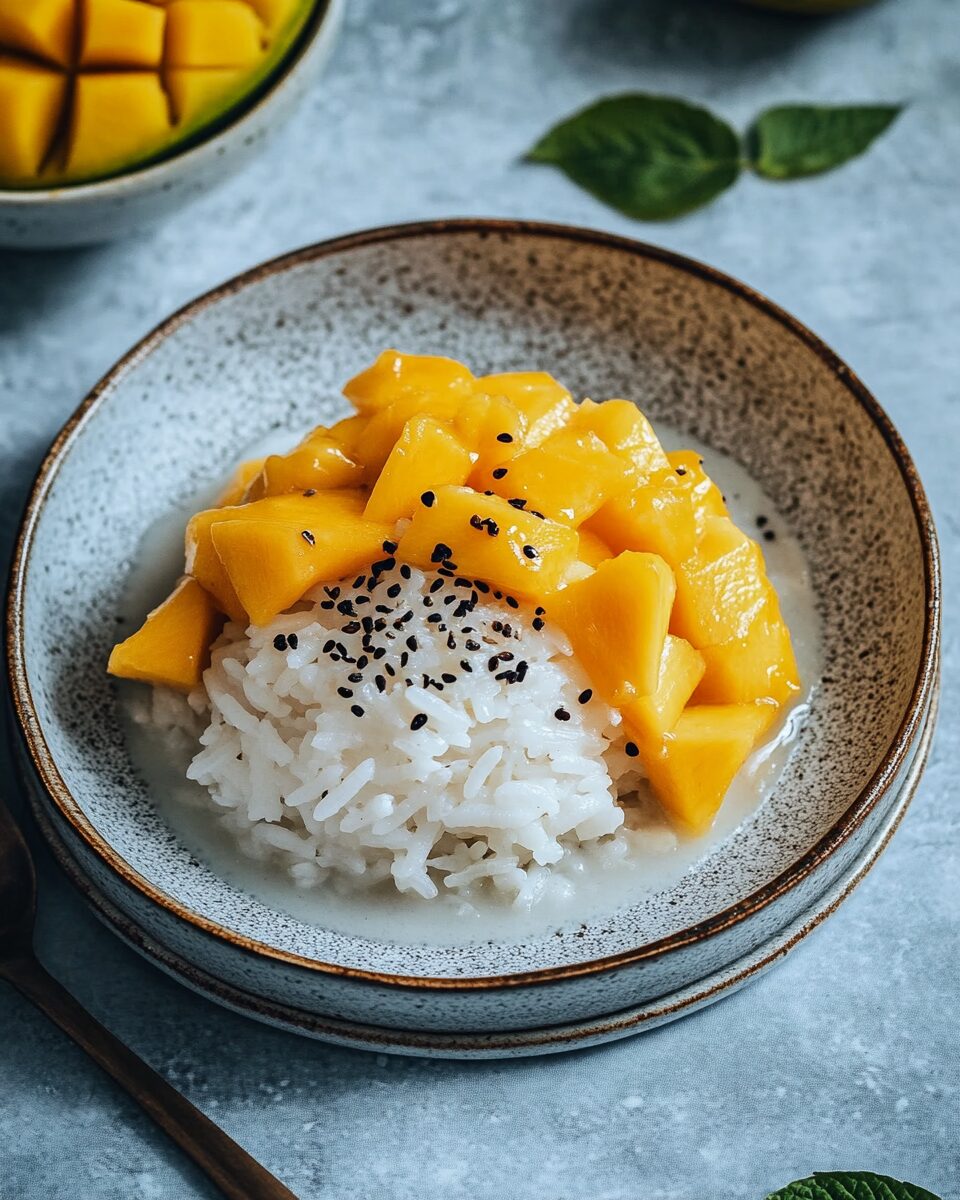Mango sticky rice is a harmonious blend of textures and flavors—creamy, chewy, sweet, and fruity—all on one plate. The glutinous rice absorbs the rich coconut milk, creating a luscious base that pairs beautifully with the bright, juicy mango slices. The contrast between the cool, fresh fruit and the warm, silky rice offers an unforgettable sensory experience. The dish is often garnished with toasted mung beans or sesame seeds, adding a subtle crunch that enhances its texture.
This dessert is visually stunning as well. The bright golden mangoes sit atop the pearly white sticky rice, often served on a simple plate or banana leaf for a traditional touch. The colors pop, making it an inviting and photogenic treat. Whether enjoyed on a tropical beach or at home, mango sticky rice embodies warmth, sweetness, and comfort, capturing the essence of Thai hospitality and culinary heritage.
Full Recipe:
-
1 cup glutinous (sticky) rice
-
1 1/2 cups coconut milk
-
1 cup sugar
-
1/2 teaspoon salt
-
2 ripe mangoes, peeled and sliced
-
1 tablespoon toasted sesame seeds or mung beans (optional)
Directions:
-
Soak sticky rice for several hours or overnight, then steam until tender.
-
Heat coconut milk, sugar, and salt until dissolved.
-
Pour the sweetened coconut milk over the cooked sticky rice and let it absorb.
-
Serve the sticky rice alongside fresh mango slices.
-
Garnish with toasted sesame seeds or mung beans if desired.
Prep Time: 10 minutes (plus soaking time) | Cooking Time: 20 minutes | Total Time: 30 minutes (plus soaking)
Kcal: Approximately 350 kcal per serving | Servings: 4
Mango Sticky Rice: A Thai Dessert Staple
Mango Sticky Rice is a beloved dessert that originated in Thailand and has become popular worldwide due to its simplicity, richness, and delightful combination of flavors and textures. This dessert brings together the luscious sweetness of ripe mangoes and the creamy, slightly salty taste of coconut-infused sticky rice, making it a delightful treat for any occasion. Whether you’re having it as a dessert after a traditional Thai meal or simply craving something sweet and refreshing, Mango Sticky Rice is sure to satisfy your taste buds.
The History and Cultural Significance of Mango Sticky Rice
Mango Sticky Rice, or Khao Niew Mamuang in Thai, is a dessert deeply embedded in Thai culture. It’s a dish that is often served during the summer months when mangoes are in season, typically between March and May. This dessert is frequently enjoyed during Thai festivals, celebrations, and family gatherings. In fact, the combination of mangoes and sticky rice symbolizes a perfect balance between sweetness and comfort, a quality valued in many cultures.
The use of coconut milk in the dessert is another cultural symbol in Southeast Asia. Coconut is a fundamental ingredient in Thai cooking, contributing richness and a distinct flavor to both savory and sweet dishes. Mango Sticky Rice, with its coconut milk base, reflects the fusion of fresh, tropical ingredients that are abundant in Thailand. It has not only become a staple dessert in Thai cuisine but also a symbol of Thai hospitality, often served to guests as a special treat.
What Makes Mango Sticky Rice So Irresistible?
At first glance, Mango Sticky Rice may seem like a simple dish, but it offers layers of flavors and textures that make it incredibly satisfying. The sticky rice, known for its chewy and soft texture, absorbs the coconut milk sauce, which is both rich and slightly sweet. This creamy base contrasts perfectly with the juicy, fragrant mango slices that are added as a topping. The combination of warm, coconut-infused rice and chilled, sweet mangoes creates a balanced and comforting dessert that appeals to many.
One of the reasons Mango Sticky Rice has gained global popularity is its versatility. It can be easily adjusted to cater to different tastes and dietary preferences. For example, the amount of sugar in the coconut milk can be altered for those who prefer a less sweet version of the dessert. Some variations of the recipe even include toasted sesame seeds or mung beans for added texture and a touch of crunch.
In addition to its delicious flavor profile, Mango Sticky Rice is visually appealing. The bright yellow mango slices stand out against the soft, white sticky rice, making the dish not only a treat for the taste buds but also for the eyes. This vibrant and beautiful presentation is a perfect way to end any meal, whether it’s a casual family dinner or an elegant dinner party.
Choosing the Right Mango for Mango Sticky Rice
The key to making an unforgettable Mango Sticky Rice lies in selecting the right mangoes. While there are many different varieties of mangoes available, the Keo Savoy or Nam Dok Mai varieties are typically used for this dessert. These types of mangoes are known for their sweet flavor and buttery texture, making them ideal for pairing with sticky rice. Their flesh is soft, juicy, and free from fiber, making them a perfect complement to the rich, coconut-infused rice.
When choosing mangoes, it’s important to select ones that are ripe but not overly soft. A ripe mango should give slightly to gentle pressure but shouldn’t feel mushy. The skin color of the mango can vary depending on the variety, but it should generally be golden yellow when ripe. Mangoes that are not fully ripe can be too tart and lack the sweetness needed for this dessert.
If you’re unable to find these specific varieties of mangoes, you can still use other types of mangoes available at your local grocery store. Just make sure they are ripe and sweet to ensure the dessert’s flavor isn’t compromised.
The Art of Making Sticky Rice
While Mango Sticky Rice is relatively easy to prepare, the process of cooking the sticky rice requires a bit of attention to detail. Sticky rice, also known as glutinous rice, has a different texture compared to regular rice. It is not washed with water before cooking and requires soaking for several hours before steaming to achieve its signature sticky and chewy consistency.
To prepare sticky rice, you’ll need a bamboo steamer or a cheesecloth to ensure the rice steams properly. The rice should be placed in the steamer without being submerged in water, allowing it to cook evenly. Once the rice is steamed to perfection, it is mixed with a coconut milk mixture, giving it a rich and smooth flavor.
One of the secrets to perfect Mango Sticky Rice is to let the rice sit for a few minutes after it has been mixed with the coconut milk. This allows the rice to fully absorb the coconut sauce and achieve the right consistency. The coconut milk should be warm, but not boiling, when added to the rice, as this helps the rice to soak up the flavor without becoming too soggy.
Customizing Mango Sticky Rice: Variations and Additions
Mango Sticky Rice is incredibly versatile, and there are many ways to customize the dish to suit your personal taste or dietary needs. Some variations include adding different fruits, such as pineapple or papaya, to the dish for an extra layer of flavor and texture. These tropical fruits pair beautifully with the coconut rice and mango, adding their own unique sweetness and tanginess.
For a more decadent version, you can drizzle extra coconut milk on top of the dessert, or even add a spoonful of sweetened condensed milk for additional creaminess. Some recipes also suggest garnishing the dessert with toasted sesame seeds or mung beans, which add a delightful crunch and a pop of color to the dish. These additions not only enhance the flavor but also elevate the presentation, making the dessert more visually appealing.
If you want to make Mango Sticky Rice vegan, simply ensure that the coconut milk is the only dairy used in the recipe. This dessert is naturally gluten-free and dairy-free, making it a great option for those with dietary restrictions. You can also make it lower in sugar by adjusting the amount of sweetener used in the coconut milk mixture, ensuring that the sweetness of the mangoes still shines through.
Serving Mango Sticky Rice
Mango Sticky Rice is best served at room temperature or slightly chilled. The sticky rice should be soft and warm when served, while the mangoes should be fresh and cold. This contrast in temperature adds to the enjoyment of the dessert, making each bite a refreshing experience.
The dessert can be plated individually or served family-style in a large dish. For individual servings, you can scoop the sticky rice onto small plates and top it with mango slices. You can also garnish with a sprinkle of sesame seeds or mung beans for added texture. If serving family-style, simply pile the sticky rice onto a platter and arrange the mango slices on top.
Mango Sticky Rice is not only delicious but also highly photogenic, making it an excellent dessert for gatherings, parties, or any special occasion. Its bright colors and delicate presentation make it a showstopper that will impress your guests.
Why You Should Try Mango Sticky Rice
If you’ve never had Mango Sticky Rice before, you’re missing out on a delightful culinary experience. It’s a dessert that strikes the perfect balance between sweetness, creaminess, and freshness, offering a satisfying treat that can be enjoyed by people of all ages. Whether you’re looking for a simple dessert to enjoy at home or something to serve at a special event, Mango Sticky Rice is an excellent choice.
The dessert is easy to make, requires only a few ingredients, and can be prepared in advance, making it a great option for entertaining. It also works as a light yet indulgent treat after a hearty meal. Its tropical flavors are sure to transport you to a sunny Thai beach with every bite, allowing you to savor a moment of sweetness in every spoonful.
Conclusion: A Dessert Worth Savoring
Mango Sticky Rice is a timeless Thai dessert that combines simplicity and sophistication in one beautiful dish. It celebrates the natural sweetness of mangoes, the richness of coconut milk, and the comforting texture of sticky rice. With its versatility, it can be adapted to suit a variety of tastes and dietary preferences, making it a dessert that everyone can enjoy. Whether you’re making it for yourself, sharing it with family and friends, or serving it at a dinner party, Mango Sticky Rice is sure to leave a lasting impression.
The best part? This dessert is not just about indulgence—it’s about celebrating the flavors of Thailand and connecting with the culture behind the dish. So next time you’re craving something sweet, treat yourself to a plate of Mango Sticky Rice. It’s more than just a dessert; it’s an experience that will transport you to the heart of Thailand, one bite at a time.






